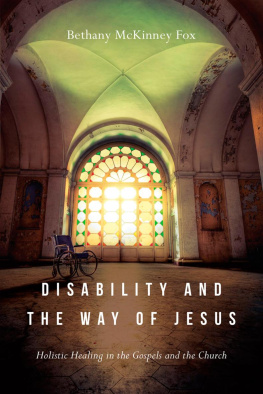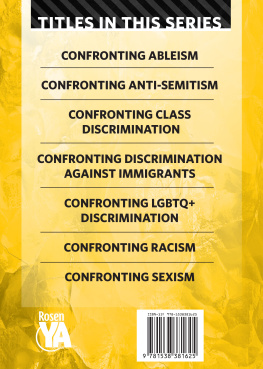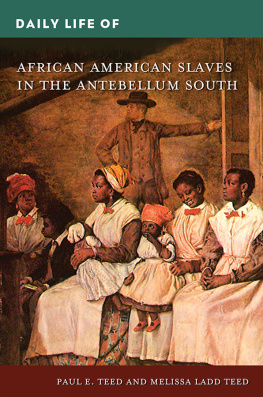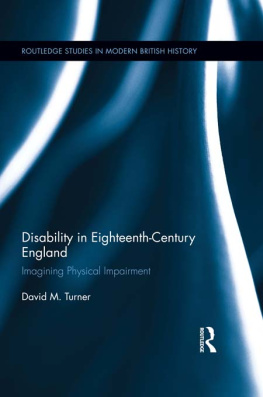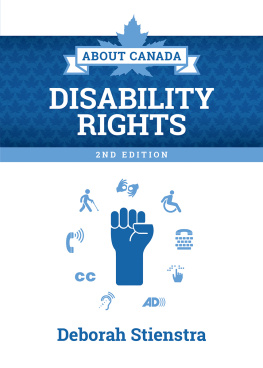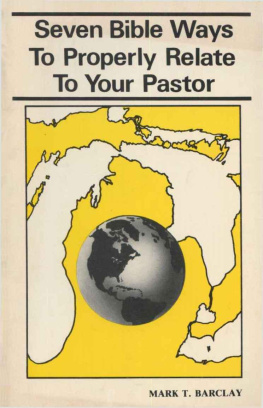2021 by the Board of Trustees
of the University of Illinois
All rights reserved
Library of Congress Cataloging-in-Publication Data
Names: Barclay, Jenifer L., author.
Title: The mark of slavery: disability, race, and gender in antebellum America / Jenifer L. Barclay.
Other titles: Disability, race, and gender in antebellum America
Description: Urbana: University of Illinois Press, [2020] | Series: Disability histories | Includes bibliographical references and index.
Identifiers: LCCN 2020038245 | ISBN 9780252043727 (cloth) | ISBN 9780252085703 (paperback)
Subjects: LCSH: SlavesAbuse ofUnited StatesHistory19th century. | African Americans with disabilitiesHistory19th century. | People with disabilitiesAbuse ofUnited StatesHistory19th century. | People with disabilitiesUnited StatesSocial conditionsHistory19th century. | SlavesUnited StatesSocial conditions19th century. | United StatesRace relationsHistory19th century.
Classification: LCC E443 .B245 2020 | DDC 306.3/62097309034dc23
LC record available at https://lccn.loc.gov/2020038245
For my parents Leon and Barbara McElhaney
In memory of Professor Michael Matambanadzo
Acknowledgments
This book has been a long time coming. For over a decade, when so few things were constant in my life, getting to this point always was. I owe a huge debt of gratitude to so many wonderful, kind, smart, patient, giving people who helped me get here. This project started as my dissertation at Michigan State University, and I will be forever grateful that I found my way there because it was where I was supposed to be.
At Michigan State, my advisor Daina Ramey Berry provided me with endless support, rigorous training, and sincere empathy when I experienced the unexpected loss of my partner. She has continued to guide and shape my career in important ways. Nwando Achebe walked beside me through that difficult time. I learned so much about my craft and about the kind of scholar I aspire to be from her amazing example. These two brilliant women, along with then-Graduate Director Keely Stauter-Halsted, helped me through that rocky beginning to continue the path that ultimately led to this book. Pero Dagbovie also influenced me in profound and enduring ways. An amazing, incredibly hardworking scholar, he inspired me to persevere and hang onto my uniqueness. I thank him for his continued friendship and belief in me. Lisa Fine also left an indelible imprint on my thinking and my teaching. Finally, I must acknowledge Tracey Jean Boisseau, now at Purdue University, who trained me for my masters degree at the University of Akron. Her keen advice led me to MSU, and I remain in awe of her brilliance as well as her strength, independence, and complete badassery. Thank you for always seeing my potential, TJ. I consider myself extremely lucky to have been trained by these spectacular scholars. For all they taught me, I owe each a deep debt of gratitude and the promise that I will pay their kindness forward.
I am also deeply grateful for the support I received as a predoctoral fellow at the University of Virginias Carter G. Woodson Institute for African American and African Studies (200911) and a postdoctoral fellow in African American Studies at Case Western Reserve University. I was a single mother and first-generation, working-class academic, so this support was instrumental to my ability to complete this project. Over these three years, combined, it was an honor to learn from so many illustrious scholars. At Case Western, Rhonda Williams challenged and inspired me. Not only is she one of the most brilliant scholars I know, she is selfless, giving, and kind to her colleagues, students, and community. Thank you, Dr. Rhonda, for all of your help and support, even long after I moved on from Case. You are truly one of the best and every African American studies scholar should aspire to your standards. Many thanks, also, to the warm community of scholars that make up Case Westerns Department of History and to Shennette Garrett-Scott. At the Woodson, I was equally as fortunate to learn from Deborah McDowell, Marlon Ross, and Cynthia Hoehler-Fatton, who worked tirelessly to create a supportive, dynamic, and collegial environment. I benefitted tremendously from my Woodson cohort and the UVA faculty who commented on my work and provided advice and support. Thank you to Risa Goluboff, Claudrena Harold, Christopher Krentz, Charles McCurdy, and Joe Miller, who gave freely of their time, knowledge, and advice. Many thanks as well to the inspiring group of pre- and postdoctoral fellows I had the privilege to work with: Jeffrey Ahlman, Tshepo Masango Chry, Benjamin Fagan, Jonathan Fenderson, Alisha Gaines, Olubukola Gbadegesin, Cassie Hays, Zetoile Imma, Anna Lim, Timothy Lovelace, Rosemary Millar, Anoop Mirpuri, Dennis Tyler, Anita Wheeler, and Thabiti Willis.
In the intervening years, so many truly amazing scholars have helped, supported, and encouraged me. I cannot thank the book series editors, Kim Nielsen and Mike Rembis, enough for their hard work, great insights, and unflagging belief in me. It has been a pleasure to get to know James Engelhardt during his time at the University of Illinois Press, who saw the potential of this project, cheered me on, and is just a genuinely wonderful person. Two other folksDouglas Baynton and Susan Burch, whose amazing scholarship and kindness humbles medeserve my heartfelt thanks. I also especially appreciate Deirdre Cooper Owens for her insightful feedback on this project. So many others have also encouraged and inspired me: Rabia Belt, Dea Boster, Doug Egerton, Rosemarie Garland-Thomson, LaShawn Harris, Sakina Hughes, Stefanie Hunt-Kennedy, . I would like to acknowledge and thank the South Carolina Review and Oxford University Press, respectively.
As I often tell my students, librarians and archivists are the people for historians to know. I genuinely appreciate and am so thankful for the hard work and dedication of the many people who helped me. This book would not have been possible without them. At the Virginia Historical Society, I benefitted tremendously from the kind assistance and generosity of Eileen Parris, Frances Pollard, and other staff members. At the University of Virginia, I accessed materials at the Albert and Shirley Small Special Collections Library and the Claude Moore Health Sciences Historical Collections. Sonya Coleman and Joan Echtenkamp Klein were instrumental to my research. Many kind students and staff also assisted me at Alderman Library. Teresa Roane at the Museum of the Confederacy in Richmond as well as the staff at the Swem Library at the College of William and Mary were incredibly helpful. At Case, Jennifer Nieves at the Allen Memorial Medical Library was a wonderful resource, as was archivist Ken Grossi and many others at nearby Oberlin College.


